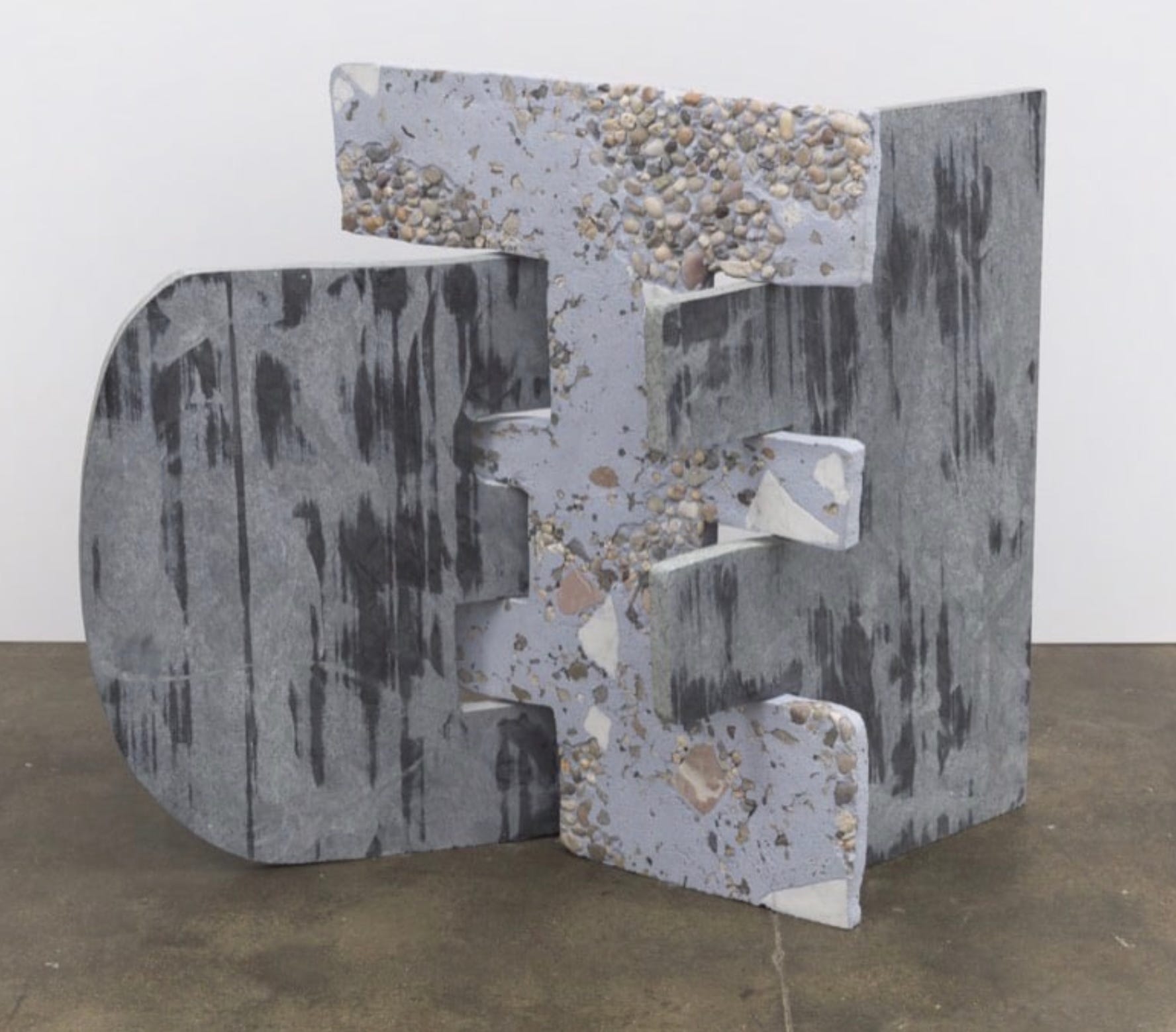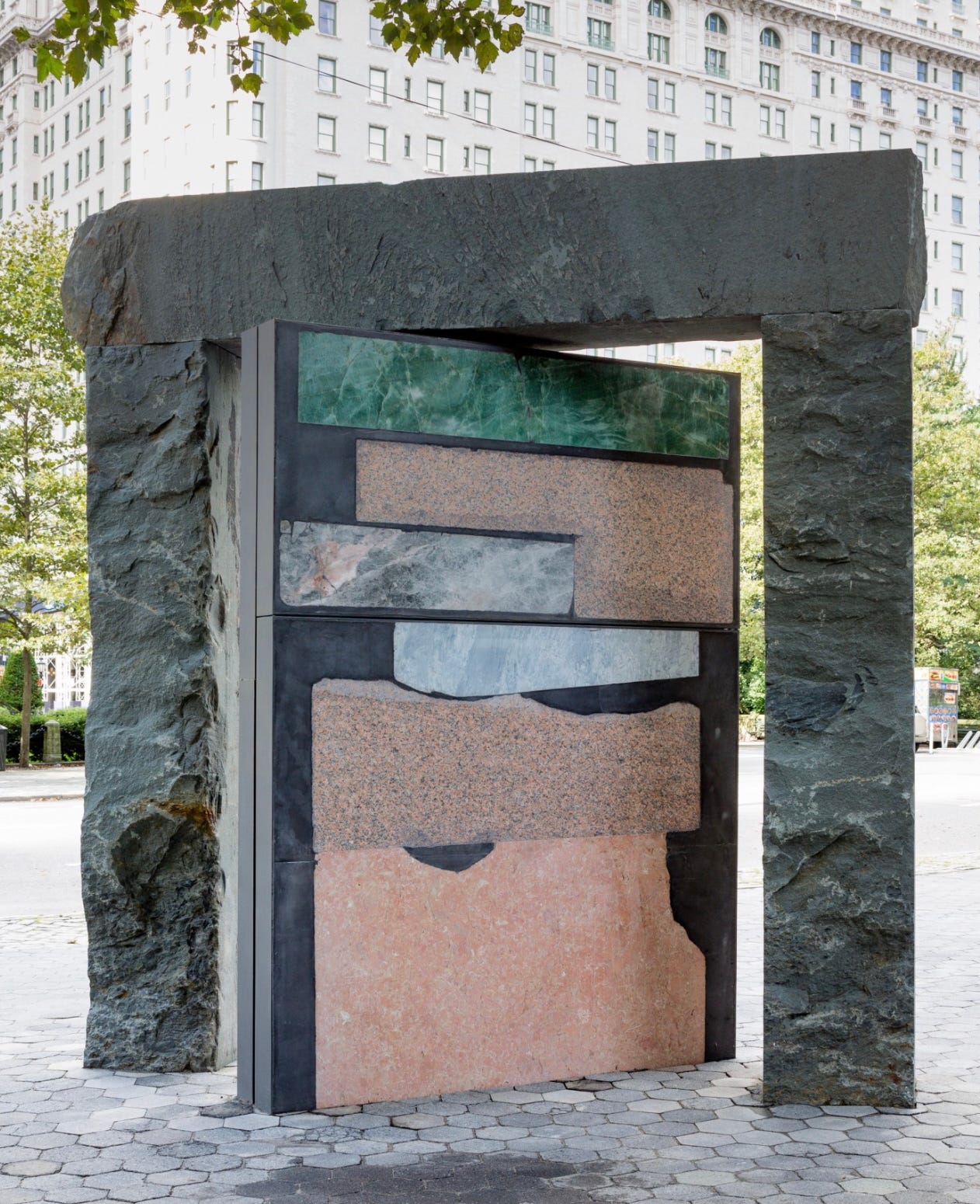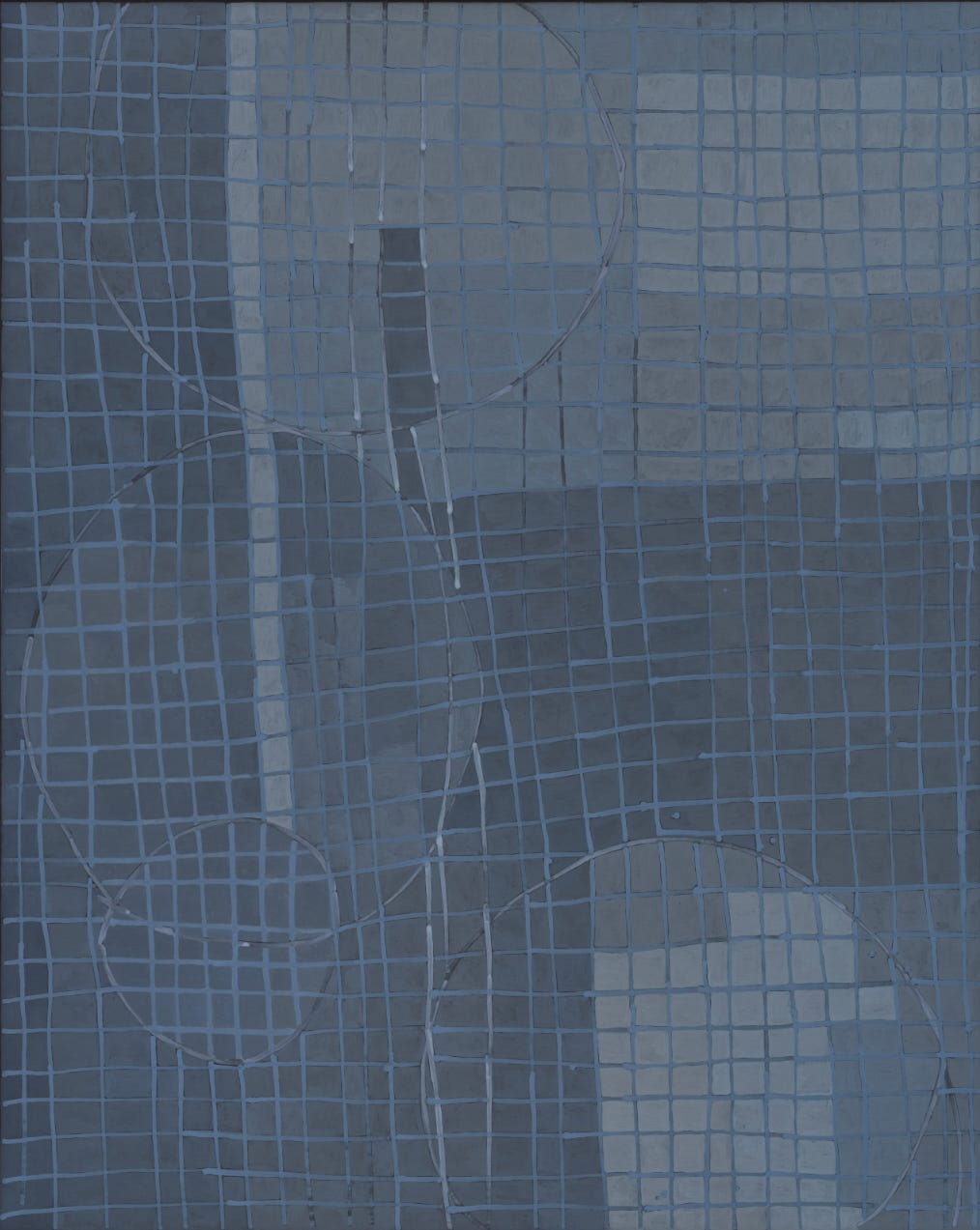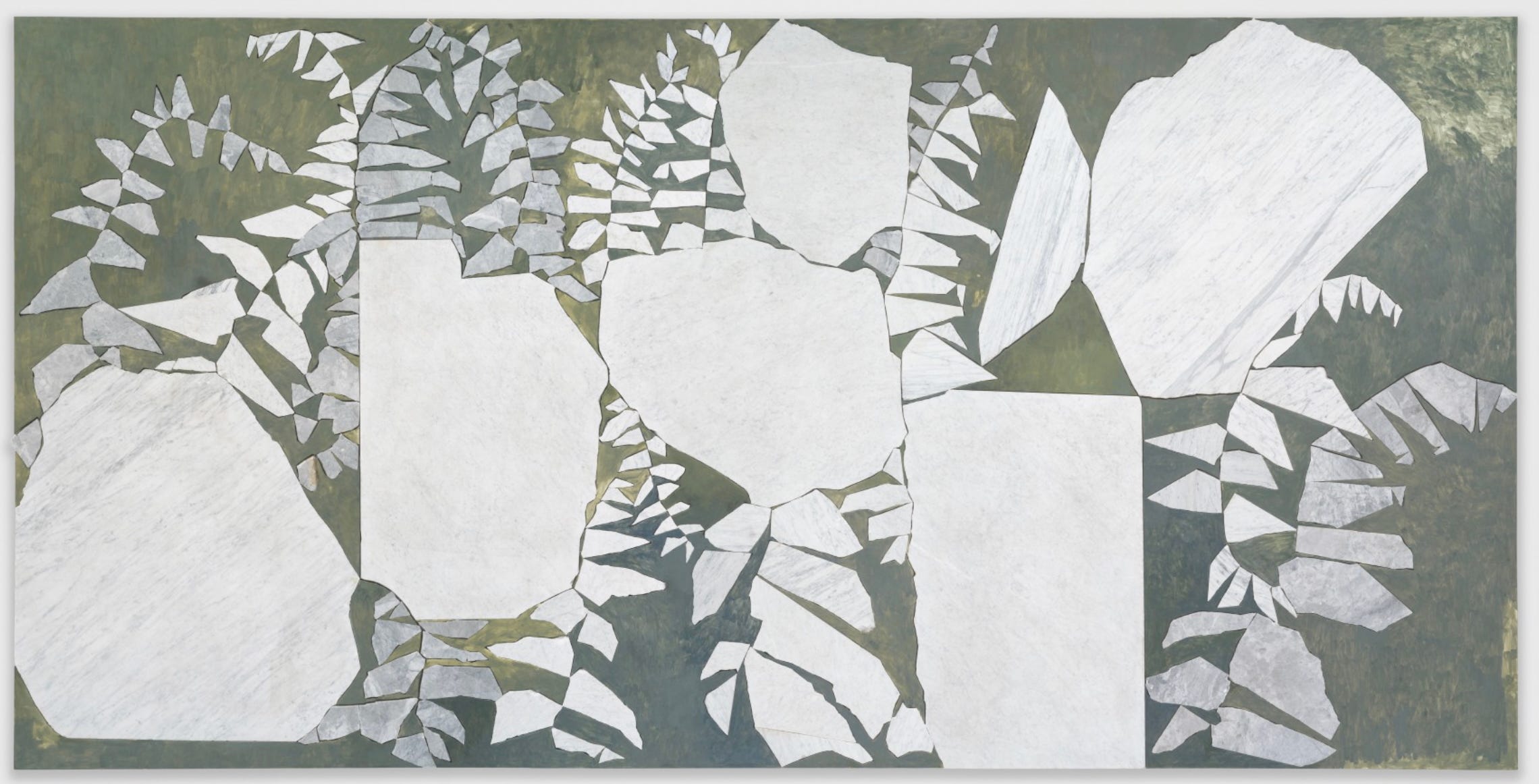
American artist Sam Moyer, born in Chicago in 1983, is currently featured in two exhibitions in New York City. Closing on June 14, Subject to Change at Sean Kelly features recent work, while Woman with Holes at Hill Art Foundation, combines a career survey of Moyer’s works with objects from the Hill Collection and will be open through August 1st.
Though she trained as a photographer and creates prints, paintings, and sculptures, Moyer sees her current works as reflecting her experience of multiple media as they combine the weighty presence of sculpture, handmade qualities of her printmaking and work with glass and paper, the touch of a painter’s hand, and the photographer’s sensitivity to light and shadow. Beach Dice (above), created this year and included in the show at Sean Kelly, is one of the artist’s “stone paintings.” She embeds fragments of reclaimed stone in plaster-covered, painted canvas; here fragments of granite are arranged as if attached to a central stem. Moyer frequently permits one or more pieces of the stone to protrude from the edge of the composition as she has here. The patchily painted pink background contrasts strongly with the dark, polished stone fragments. For the artist, this duality of shiny, reflective stone and matte, light-absorbing background is essential to her “stone paintings.”
There has to be a relationship between the stone and me. Sometimes it’s color and shape, and sometimes it’s just like the stone told me to do something with it. – Sam Moyer

Moyer varies the size of her works, largely in response to the imagery suggested by the broken stone she is using. Clipping 11 (2024) contrasts small pieces of white marble with a painted green background that encourages the viewer to see a fragment of foliage in the work. The works in the series called Clippings tend to be smaller; this work is about two feet wide. Beach Dice is more monumental at six feet wide and other pieces are even larger.
The artist collects pieces of stone countertops and floors to break up for her collage-like stone paintings. She begins by fracturing the reclaimed stone with a hammer, embracing the unpredictability of the stone’s breaking. The next step is choosing the pieces that will make up a composition, often creating arrangements that connect to nature. The merging of the constructed and the organic is a thread which runs through the artist’s career.
Once Moyer has selected and arranged her pieces of stone on the white-plastered canvas, she chooses the background color. In earlier works this color tended to be more uniform than in the two examples here; the artist says she is enjoying varying the color in a more expressive application. Once the canvas is painted and the stones are carefully polished, the two elements are combined on a support which cradles the stone in the canvas, creating the effect of a two dimensional image.

Moyer’s interest in combining materials in intertwined formats is apparent in her sculptural works. Dependents 4 (2021) comes from a series of sculptures created from flattish pieces that seem to have been mislaid from a giant jigsaw puzzle. As is typical of the artist’s fascination with contrasting textures, the constituent pieces are made from different materials: soapstone and concrete, dyed blue and embedded with beach pebbles in the example here. The interlocking pieces need one another for the work to stand upright resulting in a diversity of color, pattern, shape, and texture becoming a unified whole.
I want the work to have a generosity, to leave enough space for the viewer to bring their personal experience. – Sam Moyer
As with her stone paintings, the works from Moyer’s Dependents series are scaled to suit the human form, rendering them approachable. The textural contrasts and familiar materials also draw viewers to the artist’s objects. One feels that one knows marble countertops: what they are used for, what the material is, but in all of Moyer’s works, they are removed from that familiar context, and presented anew. The artist wonders if that challenges viewers to think about the nature of her materials or if they just accept the new format. In the end, though, any engagement with the work is the artist’s goal, whether one wonders how the work was created, analyzes its artistic elements, explores the surrealistic combination of familiar and unfamiliar, or simply surrenders to the immediate impact of the work.

Doors for Doris, of which the pictured section is only one-third, is a monumental set of sculptures created for the Public Art Fund in New York; they were installed at an entrance to Central Park between September 2020 and October 2021. In talking about these sculptures, Moyer discussed the exciting transition represented by passing through a door into a new space. The “Doris” of the title is Doris C. Freedman, the Fund’s founder. At over 12 feet tall, these sculptures might appear to lack the approachability of Moyer’s smaller works, but doors are universally familiar and these have the same appealing collage-like interaction of shape and materials found in Moyer’s other works. The rough-textured frame is local bluestone and the smoothed door element is made of reclaimed marble pieces which originated all over the world. The resulting sculptures can be seen as a metaphor for the diversity and interconnectedness of a big city. The sculptures have been acquired by the Buffalo AKG Museum and plans are underway for Doors to be installed permanently in a new city park in Buffalo, New York.

From Moyer’s largest work, we turn our attention to one of her smallest, Small Bond No. XXXVIII (2018), a fused glass plaque that is just over 13 inches tall. Using pieces of colored glass, the artist created arrangements which suggest the carefully controlled designs of architectural elements. The pieces were then heated in a kiln to fuse the glass. It was at this point that Moyer gave up her control in favor of uncertainty, just as she does when she takes a hammer to a marble countertop. The resulting plaque has many of the elements she designed: the verticals and horizontals, openings between the pieces. However, the edges have softened and the forms appear more organic than architectural. The Small Bonds are hung so that they appear to float in front of the wall. Light reflects on the surfaces but also passes through the glass, projecting the colors beyond the object. Rather than the physical materials alone, the glass AND light contribute to the work’s meaning.

Included in both current exhibitions are works produced during Moyer’s time at Dieu Donné, a non-profit institution in Brooklyn which has collaborated with artists in creating handmade paper works since 1976. (https://www.dieudonne.org/) The artist was invited to serve as Dieu Donné’s prestigious Lab Grant Resident beginning in 2024. Soft Mod 14 is one of the series she made there, using cotton and abaca pulp. I chose this example because the grid format Moyer used reminded me of the blending of architectural and organic qualities in Small Bond No. XXXVIII. Though in a very different medium, the layering of colors and textures is also similar. Moyer built up different layers of pulp in different colors, building areas of light and color by removing sections of pulp to reveal underlying layers. The artist found the process similar to her sculptural work because of its tactility, the physical action of manipulating the pulp. This process sometimes led to unexpected results, which one imagines pleases Moyer, given the pleasure she has expressed about uncertainty in making her glass and stone pieces. The different colors and fibers also create a variety of textures in the paper; according to Moyer, the white areas are translucent, a quality that is unfortunately lost in the framing of the sheets.

Another work which connects to Soft Mod 14 is the oil painting Large Payne 45, painted this year and included in the Sean Kelly exhibition. The Paynes are a series of paintings begun in 2020 in which the artist uses a very limited palette based on the color known as Payne’s Grey. The dark blue-grey color originated with an 18th century English watercolor artist William Payne. Moyer likes it because it reminds her of the light that occurs between sunset and nightfall, when colors become muted and contrast is reduced. These paintings often contain grid patterns, like those found in window screens and panes, so the titles are a bit of punning wordplay. Large Payne 45 is my favorite of the series as the different circles embedded in the irregular grid lines add contrasting shapes to the subtle variations of color. The variable, wobbly lines give a personal, hand-made effect to the Payne series, perhaps a reflection of the artist’s appreciation of the Abstract Expressionist artists’ tendency to lay bare the process of the work’s creation. Moyer has said of her own recent works that “The viewer is invited into the actual moment of creation with these works” which could easily have been said by Action Painters like Jackson Pollock and Franz Kline.

Fern Friend Grief Growth (2024), now showing at the Hill Art Foundation, is the largest of the stone paintings in either of Moyer’s current exhibitions. Ten feet tall and twenty wide, the work consists of white and grey marble “boulders” and “ferns” against a background of green tones. In spite of the size of the finished work, all of the pieces of stone could still be manipulated by the artist alone or with a single assistant, in keeping with the artist’s commitment to her handmade ethic. So large a work creates an immersive environment for the viewer. As displayed in the current exhibition, the work is accompanied by a stainless steel tumbleweed from 2017 and a 2014 bronze fragmentary human figure by Liz Glynn (American, b. 1981). This arrangement enhances the sense that Moyer’s work is part of a natural environment into which the viewer has strayed.
In this video, the artist describes her exhibition Woman with Holes at Hill Art Foundation, New York through August 1
I want my work to exist in multiple realms at once. I was thinking about cinema and film and the scale of the screen, and having it be the sole focus when you walk into the room. – Sam Moyer
Sam Moyer deeply values the physical qualities of her materials and enjoys the seeming contradiction of using construction materials as art materials. In her 20 year career, she has steadily expanded the repertoire of materials with which she is comfortable. Her art presents the viewer with many dualities: smooth vs. rough, surface vs. void, grid vs. circle, reflective vs. matte, light vs. shadow, and constructed vs. organic. With all of these, the artist hopes to entice the viewer into a relationship with her unexpected works.
Exhibitions:
Sam Moyer: Subject to change, through June 14, 2025 at Sean Kelly, 475 Tenth Avenue, New York, New York, USA: https://www.skny.com/exhibitions/sam-moyer3
Sam Moyer: Woman with Holes, through August 1, 2025 at Hill Art Foundation, 239 Tenth Avenue, Third Floor, New York, New York, USA: http://hillartfoundation.org/art/exhibitions/view/sam-moyer-woman-with-holes/
Your comments and questions, as well as likes, shares, and restacks are much appreciated. Thank you for reading and subscribing. We’ll be back with more art soon.




I tried to immerse myself into the works but it just didn’t happen for me.😢
Excellent work and an excellent write-up. Thank you